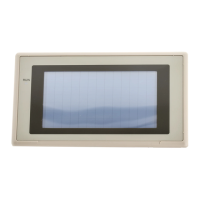2-3SectionMemory Tables
88
Property
Possible Settings
Property
Meaning
Screen
No.
0001 to 3999: Screen numbers 1 to 3999
9001: Occurrence history screen
9002: Frequency history screen
9020: Screen for Programming Console function (expansion
function)
9021 to 9023: Screens for Device Monitor function (expansion func-
tion) (Not supported by NT21.)
9030: Brightness and contrast adjustment screen (Not sup-
ported by NT21.)
9999: Return to previous screen designation
Number of screen displayed when the message (which is displayed
when the status of the bit allocated for the bit memory table entry chan-
ges to 1 (ON)) is pressed twice.
String
0 to 1999 (within the character string memory table range)
Table
Entry
Number of the character string memory table entry whose contents are
displayed as a message in the alarm list/history when the status of the
bit allocated for the bit memory table entry changes to 1 (ON).
Image/
Library
Code
000H: No display (No check mark)
0001 to 0FFF
H: Image data
1000 to 3FFF
H: Library data
Code (expressed as 4 hexadecimal digits) of the image/library data cor-
responding to the message displayed when the status of the bit allo-
cated for the bit memory table entry changes to 1 (ON).
Fore-
Black/Blue/Red/Magenta/Green/Cyan/Yellow/White
ground
Color
Color of message text (only white or black for the NT21, NT31, and
NT631)
If the alarm list and alarm history functions are registered for a screen, mes-
sages and image/library data are displayed in accordance with the status of the
bit memory table entry (refer to Common Attributes on page 86).
Reference: The alarm history can also be checked by pressing the Alarm History touch
switch on the MAINTENANCE MODE MENU screen of the PT. For details, refer
to section 6 of the Setup Manual.
When a bit is allocated in the host for the bit memory table entry, the status of the
bit is read and processing is executed in accordance with the bit status.
However, reading is only executed in the following case.
When a function (screen changeover, alarm history) is set for the bit memory
table entry.
Bit memory table entries have no output function. The contents of bit memory
table entries are not written to bits at the host.
Bit memory table entries have no data processing function.
Relationship with Other Elements
• When the alarm list function is used, messages and image/library data can be
displayed in real time in accordance with the status of bits at the host (page
182).
• When the alarm history function is used, the time when the status of the host bit
changes to 1 (ON), and the number of times it comes ON, can be displayed
(page 182).
Input Functions
Output Functions
Processing Functions

